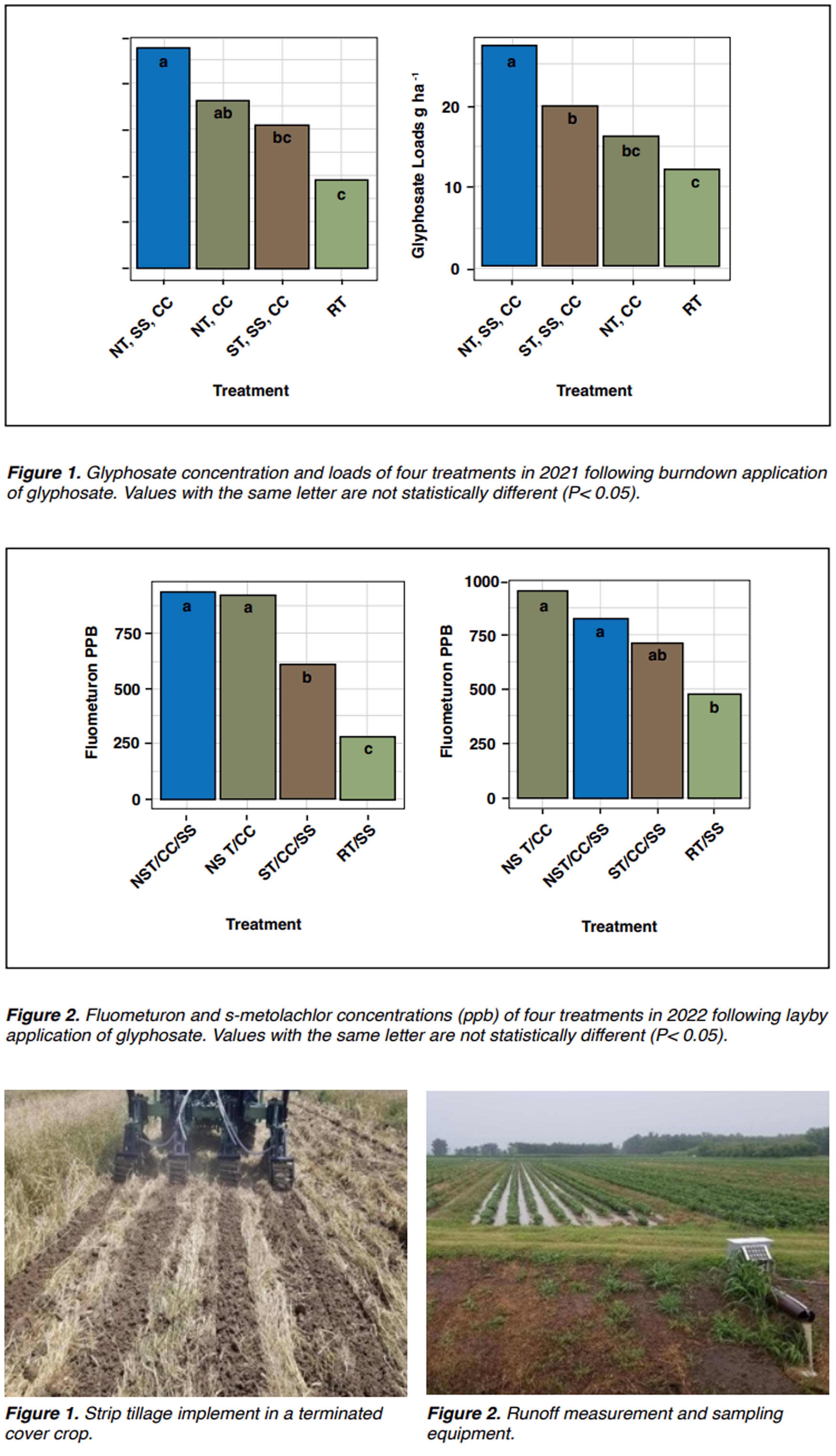Research Project
Cover Cropping Affects Herbicide Concentration in Runoff Water
Investigators: Carson Roberts, Drew Gholson, Martin Locke, Dave Spencer, Whitney Crow, and Brian Pieralisi, and Nicolas E. Quintana Ashwell
Date: 2022
Project Summary
Introduction
Waterways can become polluted by runoff water containing agricultural pesticides. These pesticides have the potential to harm wildlife ecologies in both fresh and saltwater. The Mississippi Delta region contributes more pesticides than any other basin in the Mississippi River drainage system, and some blame conventional agriculture practices for the large pesticide loads. Among the crops grown in the area, cotton has far greater pesticide use than any other crop. Conservation practices including no-till and cover crops have been championed as solutions to this problem. However, few studies in the Mid-South have quantified the potential to reduce pesticides in runoff water by using conservation systems in production. This study was developed to investigate how conservation tillage and cover crop systems influence runoff water quality. It is hypothesized that water quality can be improved under conservation systems in the Mid-South.
Materials and Methods
A study is being conducted in Stoneville, MS, from 2021 to 2023 on a Dubbs silt loam (finesilty, mixed, active, thermic Typic Hapludalfs). Study treatments include reduced tillage with subsoil (RT), strip tillage (ST), strip tillage with cover crops (ST,CC), strip tillage with cover crops and subsoil (ST,CC,SS), no seedbed tillage (NST), no seedbed tillage with cover crops (NST,CC), and no seedbed tillage with cover crops and minimal surface disturbance subsoil (NST,CC,SS). This study is organized as a randomized complete block design with three replications. Plots consist of eight 40" rows that are 500' in length.
Cover crop treatments were terminated using 44 oz acre-1 of glyphosate two weeks prior to planting. After being terminated, ST plots were tilled using a strip tillage implement (Figure 1). The variety Deltapine® 2012 BX3 was planted, and routine fertility and PGR applications were made. Preemergence herbicides included Glyphosate at 44 oz/ acre, Glufosinate at 28 oz/acre, and Cotoran 4L and Dual Magnum at 24 oz/acre each. Layby applications included Cotoran 4L at 36 oz/acre and Dual Magnum at 24 oz/acre. Runoff water samples were collected during the runoff event following each application using an area velocity flow meter with an integrated, automatic composite water sampler. Samples were analyzed at Mississippi State University's chemical laboratory; glyphosate, AMPA, glufosinate, s-metolachlor, fluometuron, total nitrogen, total phosphorus, and total solids were measured. Data were analyzed in R studio using the lmer function in the lme4 package, and means were separated using unrestricted LSD.
Results and Discussion
There were differences between the treatments in both concentration and quantity of glyphosate runoff following the burndown application of glyphosate in 2021. This event showed glyphosate concentrations in the runoff water being increased by more than 2-fold where no seedbed tillage and cover crops were implemented (Figure 1). Furthermore, the total quantity of glyphosate being exported from the field was double in the NST,SS,CC and ST,SS,CC when compared to the conventional, RT treatment.
In 2022 runoff concentrations of some of the runoff events were not calculated because of equipment malfunction. Of those that were calculated, glyphosate, AMPA, glufosinate, total nitrogen, total phosphorus, and total solids in each treatment did not differ from each other. Runoff concentrations of fluomenturon and s-metolachlor did differ across the treatments that were measured following the layby application (Figure 2). The trends here follow the same pattern as trends in 2021. During the rainfall event two days following the layby application, fluometuron concentrations in the runoff water were more than three times more in both treatments where no till and cover crops were implemented compared to the RT treatment. The ST,SS,CC treatment also produced concentrations that were two times greater than the RT,SS treatment. S-metolachlor concentrations were also different, but the most severe difference between RT and any other treatment was only two-fold, and it was comparable to the ST,SS,CC treatment.
The difference between the treatments in all these different cases is likely relative to the amount of biomass in each system. Since the RT treatment has little to no biomass the opportunity for the herbicide to adhere to the soil is greater than in the cover crop systems where the herbicide can fall on the cover crop residue where adhesive potential is limited. The runoff water quantity may also play a role in the elevated levels since runoff volume is usually less in the cover crop systems.
Conclusion
Herbicide as a runoff water pollutant was not reduced by implementing cover crop and no-till practices. Concentration differences between the treatments suggest that the herbicides are not adhering to the soil as strongly where cover crops are planted. Further investigation at this site is needed to determine the potential of these systems in the Mid-South.
Project Photos

- Topic:
- Cover Crops
- Tillage
- Soil
Find Research
By Crop Type
By Topic
Contact NCAAR
General Information
Kaye Sullivan
vfs23@msstate.edu
662.390.8510
F:662.390.8501
Showcase Demo
Drew Gholson, Coordinator
drew.gholson@msstate.edu
662.390.8505
Himmy Lo
himmy.lo@msstate.edu
662.390.8509

